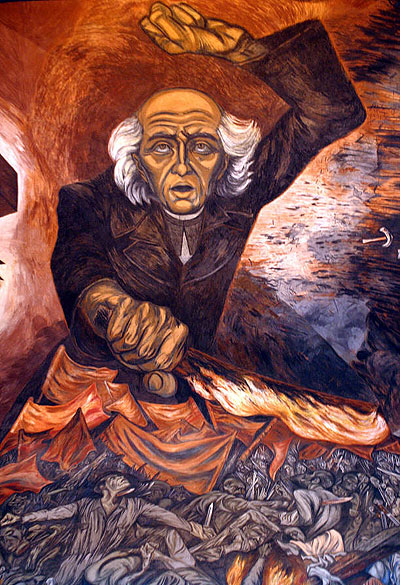|
| |
El Grito de Dolores

Photo courtesy of Edgar Hoill Photography
Hidalgo by Jose Clemente Orozco
Fresco, 1937. Governor's Palace, Guadalajara, Jalisco, Mexico
Mexico's El Dia de Independencia
On the morning of September 16th, 1810 Miguel Hidalgo issued a call to arms from the Iglesia de Dolores where he curate. The incident is referred to as the "El Grito de Dolores", which announced the beginning of the armed struggle for Mexican Independence from Spanish rule.
Father Hidaldo was to declare independence in the city of Guadalajara in Jalisco, Mexico and form a provisional government, but he was captured and executed by a firing squad on July 30th, 1811. His head, along with those of other Mexican revolutionary leaders, were hung in the Alhondiga de Granaditas in Guanajuato, Mexico.
Every year on the eve of "El Dia de Independencia", Mexico's Independence Day (September 16th), "El Grito de Dolores" is declared by thePresident of the Mexican Republic from the top of the Government Palace. At around eleven in the evening, the President of Mexico rings the bell of the National Palace in Mexico City. After the ringing of the bell, he repeats a shout of patriotism (a Grito Mexicano) based upon the "Grito de Dolores", with the names of the important heroes of the Mexican War of Independence who were there on that very historical moment included, and ending with the threefold shout of �Viva M�xico! from the balcony of the palace to the assembled crowd in the Plaza de la Constituci�n, or Z�calo, one of the largest public plazas in the world. After the shouting, he rings the bell again and waves the Flag of Mexico to the applause of the crowd, and is followed by the playing and mass singing of the Himno Nacional Mexicano, the national anthem, with a military band from the Mexican Armed Forces playing. This event draws up to half a million spectators from all over Mexico and tourists worldwide. On the morning of September 16, or Independence Day, the national military parade (the September 16 military parade) in honor of the holiday starts in the Z�calo and its outskirts, passes the Hidalgo Memorial and ends on the Paseo de la Reforma, Mexico City�s main boulevard, passing the El �ngel memorial column and other places along the way.
|
|
|
|




